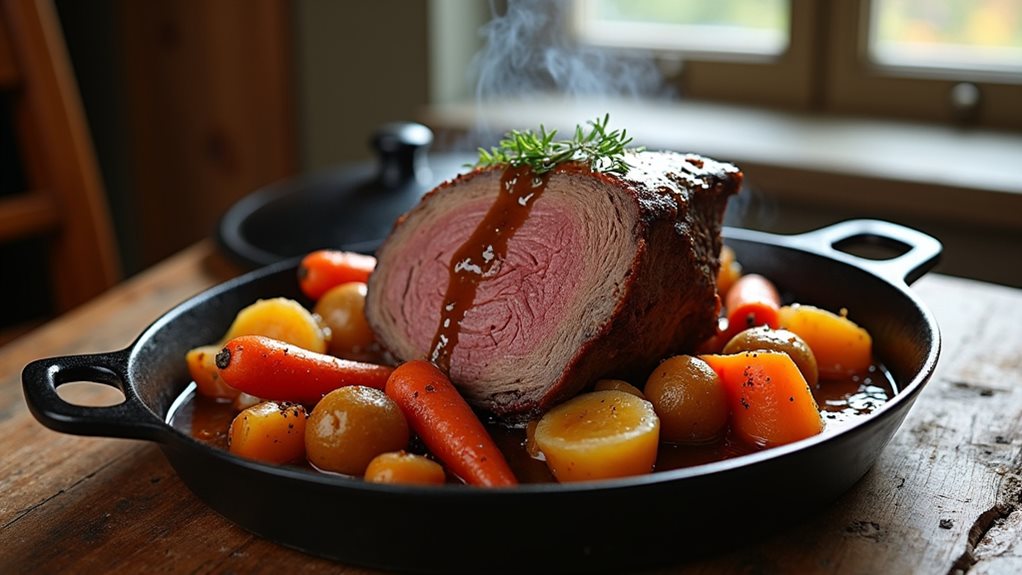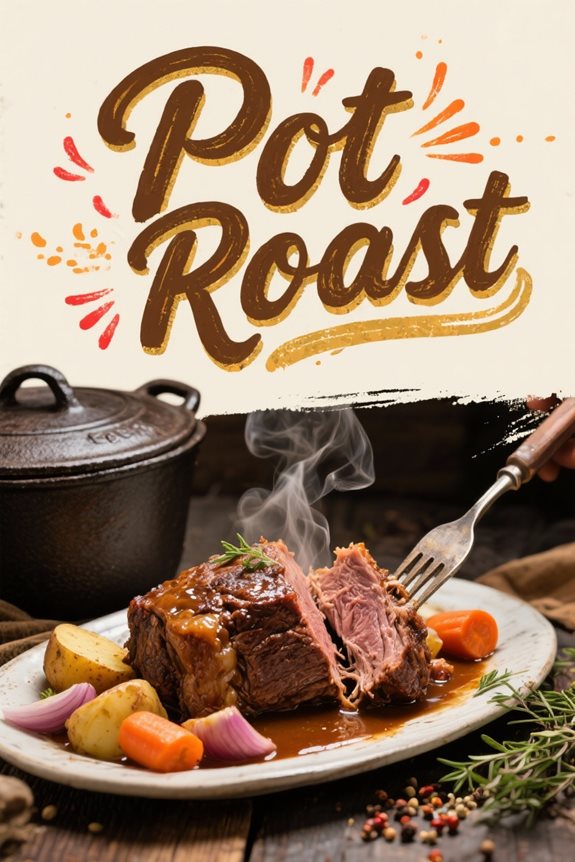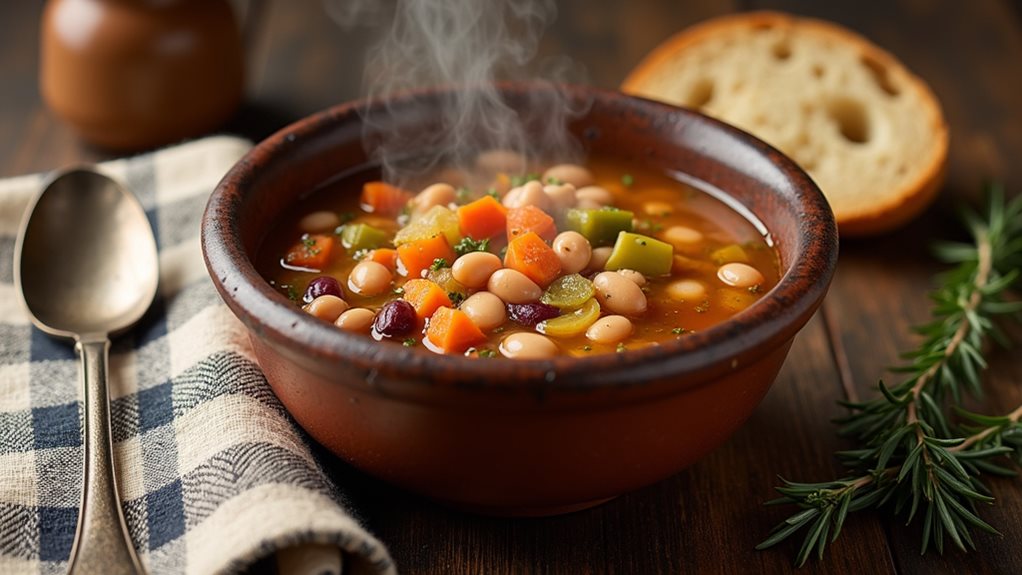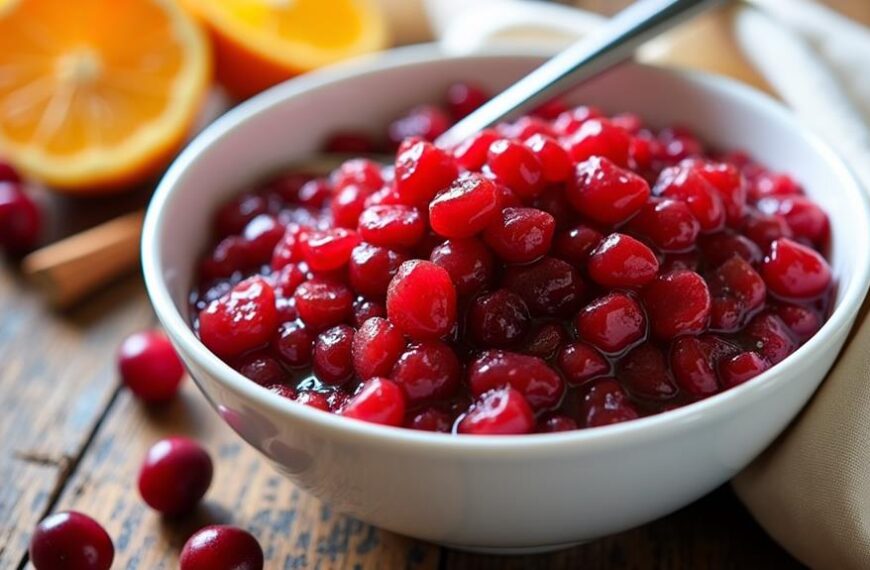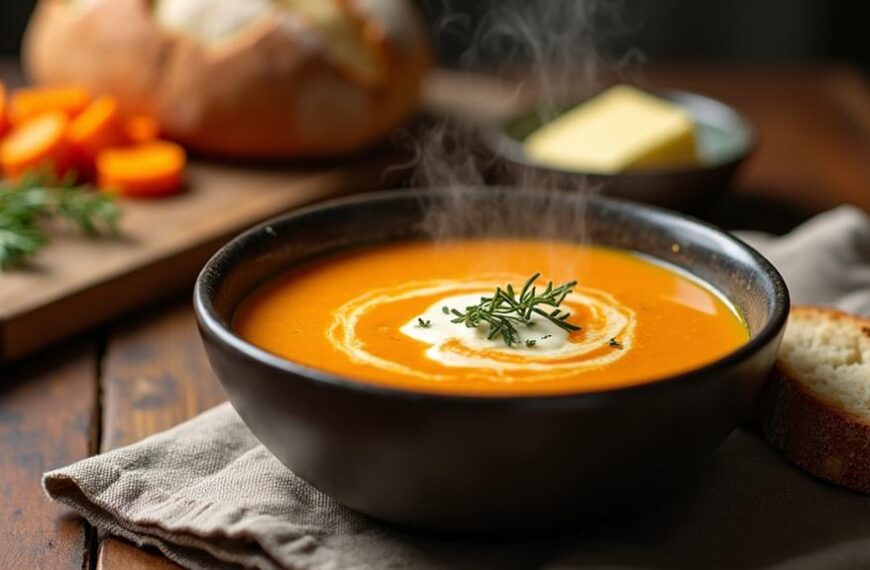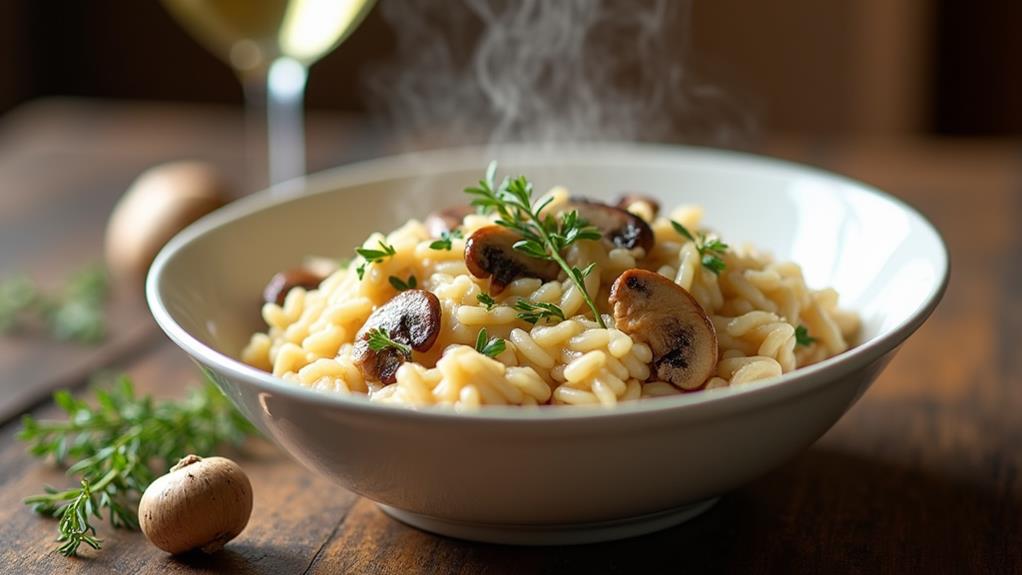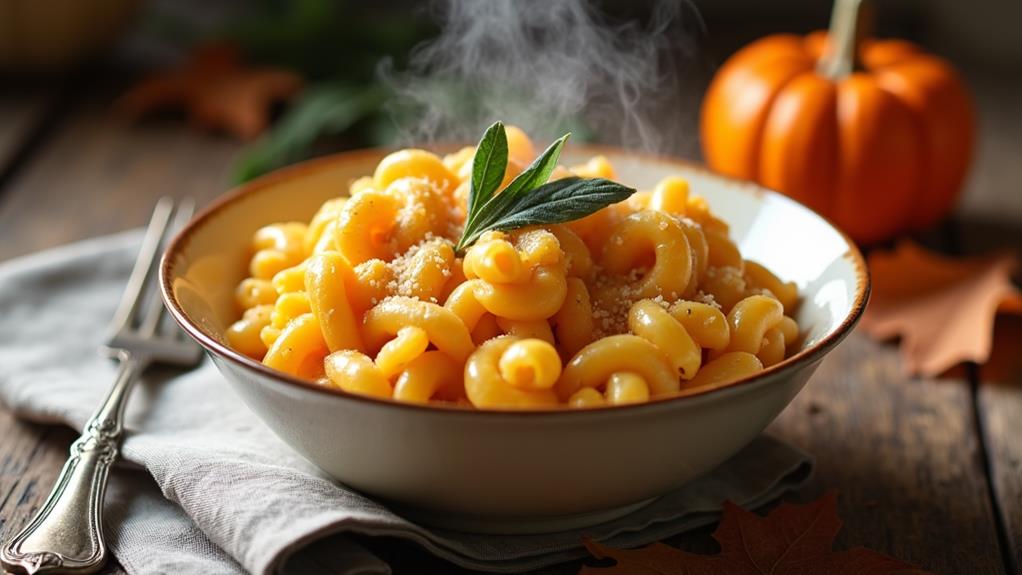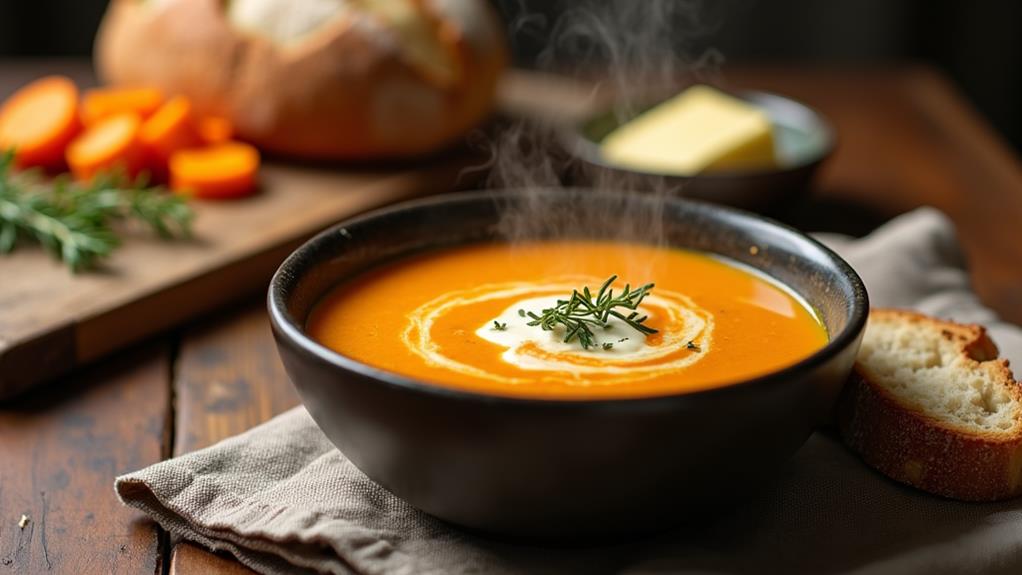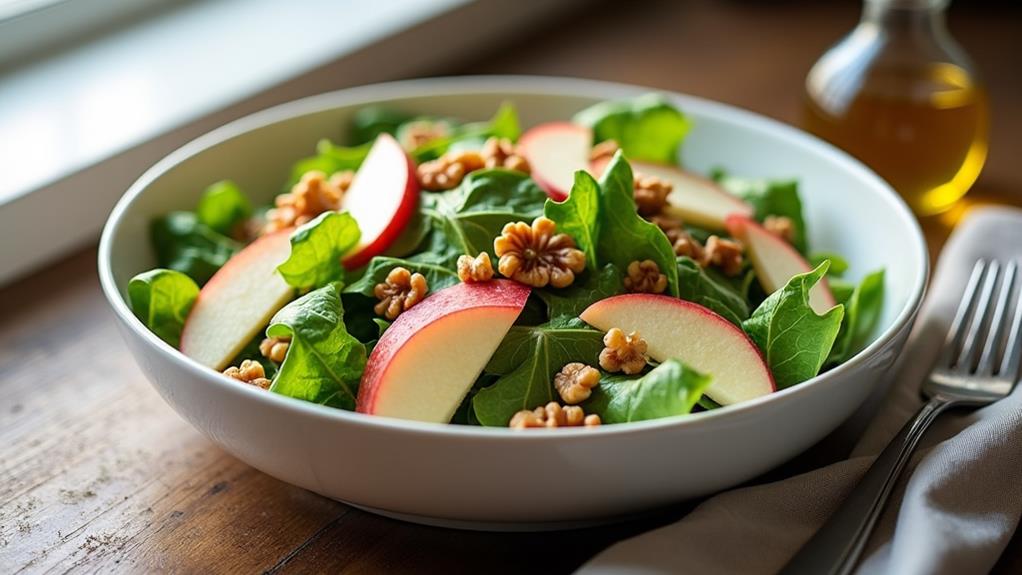I’ve been making pot roast for over twenty years, and I’m convinced it’s the ultimate comfort food for chilly evenings. There’s something magical about the transformation of a tough cut of beef into fork-tender perfection after hours of slow cooking. The rich aroma that fills your home as it simmers is just the beginning of the experience. If you’re looking for a meal that combines simplicity with deep, satisfying flavor, you’ll want to discover what makes this classic dish so special.
Key Takeaways
- Pot roast typically uses chuck roast, seared then slow-cooked for 3-4 hours until fork-tender.
- Essential seasonings include ginger, garlic salt, black pepper, and paprika for rich flavor development.
- Liquid components like tomato paste with water create the gravy base that keeps meat moist.
- Add vegetables like carrots, onions, and potatoes during the final hour of cooking.
- Serve with complementary sides such as mashed potatoes, egg noodles, or crusty bread.
Why You’ll Love this Hearty Pot Roast
When the days grow shorter and the air turns crisp, there’s nothing quite as satisfying as a hearty pot roast simmering away in your kitchen.
I’ve perfected this recipe over years of Sunday family dinners, and I’m confident you’ll appreciate its rich flavor and simplicity.
The magic happens as the chuck roast transforms during slow cooking, becoming fork-tender while absorbing the savory combination of garlic, ginger, and tomato paste.
I love how the traditional iron kettle creates the perfect environment for developing those deep, complex flavors that simply can’t be rushed.
What makes this recipe special is its versatility—you can easily adjust the seasonings to suit your family’s preferences while maintaining that classic, comforting quality that makes pot roast an enduring favorite.
What Ingredients are in Hearty Pot Roast?
When it comes to creating a delicious pot roast, the right ingredients make all the difference. A good pot roast relies on a quality cut of meat as its foundation, with just enough seasoning to improve the natural flavors that develop during the slow cooking process.
The beauty of pot roast is in its simplicity—a handful of basic ingredients transform into a comforting, savory meal that feels like home.
- Chuck roast (5 pounds, with blade in or out)
- Ginger
- Garlic salt
- Black pepper
- Paprika
- 1 can tomato paste
- Large iron kettle or 2 iron skillets for cooking
While these ingredients form the base of a classic pot roast, you might consider adding a few vegetables if you want to make it a complete one-pot meal. Carrots, onions, and potatoes are traditional additions that soak up the savory juices as they cook alongside the meat.
The tomato paste adds richness and depth to the gravy, while the spice blend creates a perfectly seasoned crust on the roast. Remember that the quality of your chuck roast matters—look for one with good marbling, as those streaks of fat will render down during cooking, keeping the meat moist and adding flavor to your finished dish.
How to Make this Hearty Pot Roast

To create this mouthwatering pot roast, start with a chuck roast (about 5 pounds, with blade in or out) and your trusty iron cookware. You’ll need either one large iron kettle or two iron skillets—these heavy-duty pieces distribute heat evenly and create that perfect sear we’re looking for.
Season your roast generously with ginger, garlic salt, pepper, and paprika, making sure to coat all sides. This flavor foundation is what transforms a simple cut of meat into something truly special.
Next, heat your iron vessel until it’s nice and hot, then place the seasoned chuck roast in to sear. The sizzle when meat hits hot iron? Pure kitchen music. Once you’ve achieved a beautiful brown crust on all sides (patience is key here), add one can of tomato paste to the pot. The tomato paste will break down during cooking, creating a rich sauce that infuses the meat with tangy depth.
Now, add just enough water to come about halfway up the sides of the roast—not too much, we’re not making soup! Cover the pot and reduce the heat to a gentle simmer. The magic happens low and slow, giving the tough muscle fibers time to break down and become fork-tender.
Let this beauty cook for about 3 to 4 hours, checking occasionally to make sure there’s still enough liquid. You’ll know it’s ready when the meat practically falls apart at the touch of a fork.
For those who prefer precise cooking methods, a professional rice cooker can be repurposed to maintain perfect temperature control for slow-cooked dishes like this pot roast.
Want to take it up a notch? About an hour before it’s done, you could add some chunky vegetables like carrots, potatoes, and onions to the pot. They’ll soak up all those savory juices and complement the rich, tender meat.
The finished pot roast should be so tender you won’t need a knife—just a fork and a healthy appetite.
Hearty Pot Roast Substitutions and Variations
While our classic pot roast recipe creates a mouthwatering meal on its own, the beauty of this dish lies in its versatility.
I’ve found that swapping chuck roast for brisket or rump roast works wonderfully when you’re looking for different textures and flavors.
Don’t have tomato paste? Try using crushed tomatoes or even beef broth with a splash of red wine for depth.
For those who enjoy herbs, I recommend adding rosemary, thyme, or bay leaves to the pot.
You can also customize the vegetables—carrots, potatoes, and onions are traditional, but parsnips, turnips, or mushrooms make excellent additions.
If you’re feeling adventurous, try incorporating dried fruit like prunes or apricots for a subtle sweetness that complements the savory meat beautifully.
What to Serve with Hearty Pot Roast
Since a rich, tender pot roast serves as the centerpiece of any meal, I’ve found that complementary side dishes can transform this classic into an unforgettable dining experience.
Traditional pairings include creamy mashed potatoes, which soak up the savory gravy beautifully, or buttered egg noodles for a comforting alternative.
For vegetables, consider roasted carrots and parsnips, which echo the flavors in the pot while adding sweetness, or a bright green vegetable like steamed broccoli or sautéed green beans to provide color contrast.
I always include a crusty bread to mop up every last bit of that precious gravy.
For a complete presentation, add a simple green salad dressed with vinaigrette to cut through the richness of the main dish.
Final Thoughts
After mastering this classic pot roast recipe, you’ll discover it becomes more than just a meal—it transforms into a tradition your family will request time and again.
The beauty of pot roast lies in its simplicity—quality ingredients, patience, and minimal technique yield extraordinary results.
I’ve found that the iron kettle makes all the difference, distributing heat evenly while developing those rich, caramelized flavors we crave.
Don’t rush the process; those hours of slow cooking break down tough connective tissues into melt-in-your-mouth tenderness.
Like many traditional cooking methods, pot roast shares culinary heritage with ancient civilizations who understood the transformative power of slow cooking techniques.

